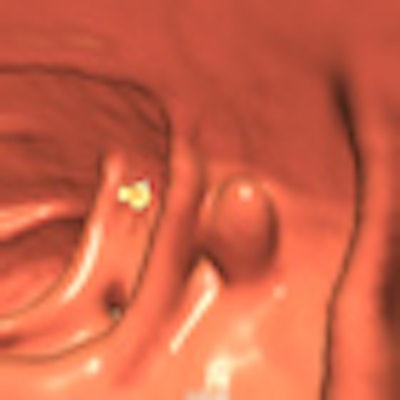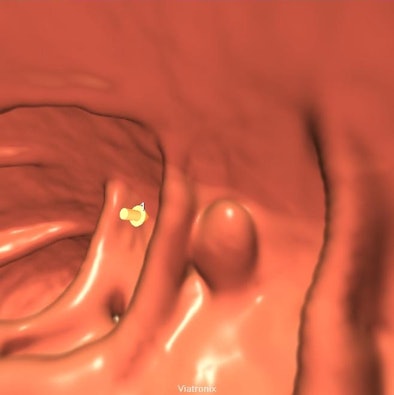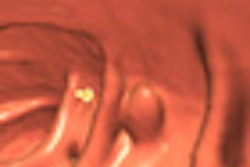
The images take a little longer to interpret, but a new study shows that minimal-prep virtual colonoscopy can deliver high sensitivity and specificity for detecting adenomas in a large colorectal cancer screening population, according to a study presented at this month's RSNA meeting.
Of equal importance from the patient's point of view was the comparative comfort of the minimal-prep exam versus conventional optical colonoscopy. If colorectal cancer screening can be made easier for patients, the thinking goes, more adults will opt to be screened with virtual colonoscopy (also known as CT colonography or CTC).
The multicenter study stood out not only for its size and prospective design, but also for its use of both electronic cleansing (EC) and computer-aided detection (CAD), using systems developed at Massachusetts General Hospital (MGH) in Boston. The high sensitivity and specificity achieved in more than 600 patients suggests that minimal-prep VC could be a viable exam for those who refuse to be screened by conventional colonoscopy, and who don't think very highly of laxatives either.
"It's been suggested that reduced or noncathartic-prep CTC, if clinically validated, might improve screening adherence," said Michael Zalis, MD, associate professor of radiology at MGH and Harvard Medical School in Boston. "The purpose of our study was to make a prospective performance estimate of noncathartic CAD-assisted CT colonography for the detection of adenomas moderate-sized or larger in a screening cohort."
Standard conventional colonoscopy using a polyethylene glycol (PEG) prep was performed in all patients, and segmentally unblinded colonoscopy performed within three weeks served as the reference standard for the study, Zalis said.
The cohort consisted of individuals at average and moderate risk of colorectal polyps and carcinoma. Excluded were individuals who had been screened in the previous five years, or who had risk factors such as a family history of colorectal carcinoma that could increase their risk of developing the disease.
The screening subjects were recruited from three Boston-area medical centers, as well as from the University of California, San Francisco. Within five weeks of virtual colonoscopy, all 604 subjects (50% men; mean age, 60.4 ± 8 years) underwent follow-up conventional colonoscopy with standard purgative bowel cleansing before colonoscopy, which, following segmented unblinding, served as the reference standard in the study, said Zalis.
Preparation for the noncathartic CTC exam included fecal tagging with iodinated oral contrast (Omnipaque 300, GE Healthcare, Chalfont St. Giles, U.K.), which was administered in small aliquots for two days prior to the exam. Hydration with the patient's choice of noncaffeinated and nonalcoholic beverages was also delivered for two days prior to the exam, as was a zero-fiber meal kit (NutraPrep, Bracco Diagnostics, Princeton, NJ) one day before the exam; no bowel purgative was used.
On the day of the exam, the colon was insufflated automatically (ProtoCO2l, Bracco Diagnostics) with CO2, and low-dose prone and supine virtual colonoscopy images were acquired using 16- to 128-detector-row CT scanners at 50 mAs or less. Electronic cleansing of the images was performed to virtually remove the tagged fecal material and fluid, and images were interpreted using CAD, Zalis said.
The previously validated CAD scheme was trained on a separate set of cases from the study cohort and used both curvature and texture features, as well as a neural network for candidate classification, Zalis told AuntMinnie.com. CAD and electronic cleansing were developed for this project in house, Zalis said. CAD was always included in concurrent reading mode, and it was trained on a separate patient cohort from the study cohort. The electronic cleansing algorithm employed advanced features that were described in previously published studies, including Hessian analysis, level set evolution, and mucosal reconstruction.
Three readers with experience in more than 100 cases each interpreted the images, using software capable of rapidly switching back and forth between 2D and 3D (V3D Colon, V2.1.3, Viatronix, Stony Brook, NY) for verification of lesion detection and problem-solving. Readers 1 and 2 chose a proprietary "zoomed" 2D interpretation method with CAD for primary reading. Reader 3 chose primary 3D with unzoomed 2D plus CAD.
Reading times were a little longer than with cathartic prep, probably owing to the difficulty of interpreting unprepped datasets, and dealing with image artifacts in the electronic cleansing algorithm. Mean reading times were 15 minutes ± 6.7 for reader 1, 13.5 minutes ± 4.0 for reader 2, and 13.3 minutes ± 4.0 for reader 3.
For all lesions 6 mm and larger, the study team calculated sensitivity per patient and per polyp, specificity per patient, and mean interpretation times. Lesion presence was confirmed by segmental unblinding of optical colonoscopy results, with standard optical colonoscopy performed within three weeks of CTC. The lesion matching employed required that matches be within the segment or an adjacent one, and within 50% of the measured lesion size in the corresponding modality.
Subjects were asked to complete a survey inquiring about comfort, any change in bowel habits associated with the prep, and severity of bowel habit changes. "What we observed was that for the noncathartic prep, there was an improvement in all of these scores compared to the optical colonoscopy prep, and all those differences were statistically significant," Zalis said.
Subject experience with bowel prep
|
||||||||||||
| Noncathartic bowel preparation yielded an improvement in patient comfort scores versus optical colonoscopy (all p < 0.0001). |
 |
| Endoluminal reconstruction above from noncathartic, electronically cleansed CT colonography exam demonstrates a colonoscopy-confirmed 1-cm advanced adenoma. The lesion is also indicated by the visible yellow arrow, which represents a CAD indicator. The advanced electronic cleansing and CAD algorithm were developed by the investigators for the trial. Image courtesy of Michael Zalis, MD. |
Results: Area under the curve, per-patient sensitivity and specificity, per-polyp sensitivity
|
||||||||||||||||||||||||||||||||||||||||||||||||||||||||||||||||||||
"In terms of sensitivity, especially for the larger lesions using the 2D approach, performance was really very much in the range that has been reported for standard cathartic CT colonography, with performance that dropped off for the smaller lesions," Zalis said. "For the third reader using a primary 3D technique, sensitivity was somewhat less in the larger size range, with a similar drop-off in performance for the smaller lesions."
Similarly, the receiver operator characteristics (ROC) curve and the per-polyp sensitivity shows better performance for readers 1 and 2, who chose a primary 2D interpretation method, Zalis said. The median electronic cleansing artifact score was 3.
The cohort size and the number of readers, while larger than in previous studies of noncathartic cleansing CTC, will likely limit the generalizability of the results, Zalis said, adding that analysis of a few cases has yet to be completed. The CAD performance also remains to be analyzed.
"Noncathartic CTC is technically feasible and is associated with significantly improved subject experience," Zalis said. "Polyp detection was comparable to standard cathartic-prep CT colonography for larger lesions, especially using a primary 2D technique."
He added that the relatively poor performance for primary 3D probably reflected the limits of electronic cleansing, which were essentially fixed 4.5 years ago when researchers began the trial. Interpretation times were also slightly more time-consuming than some of what has been reported for cathartic CTC. But, overall, the results were positive.
"In the end, the results suggest that noncathartic CTC as an option may contribute to colon cancer screening and improved screening adherence," he said.
By Eric Barnes
AuntMinnie.com staff writer
December 21, 2010
Related Reading
Second-reader CAD improves VC sensitivity, December 14, 2010
Sophisticated electronic bowel cleansing boosts polyp detection, August 3, 2009
Minimal prep VC nearly as sensitive, better tolerated, March 7, 2009
Image tools cut false positives in unprepped VC, August 4, 2008
VC CAD finds polyps in prepped or unprepped patients, May 6, 2008
Copyright © 2010 AuntMinnie.com



















